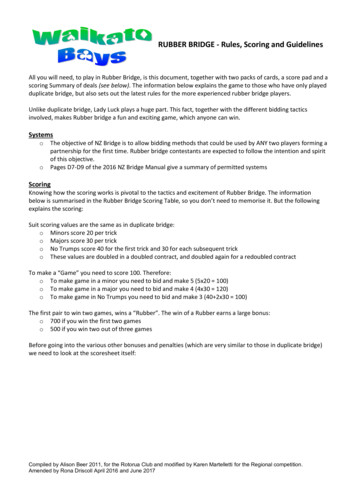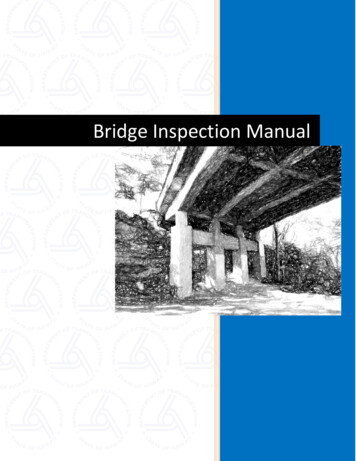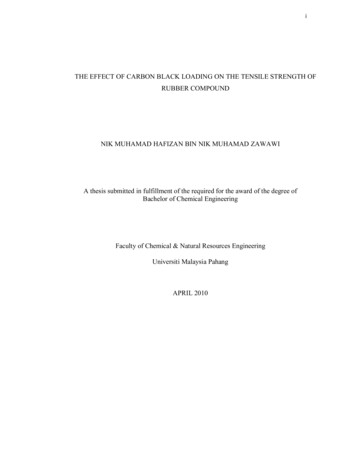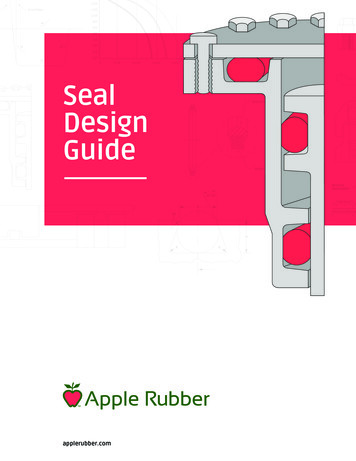
Transcription
RUBBER BRIDGE - Rules, Scoring and GuidelinesAll you will need, to play in Rubber Bridge, is this document, together with two packs of cards, a score pad and ascoring Summary of deals (see below). The information below explains the game to those who have only playedduplicate bridge, but also sets out the latest rules for the more experienced rubber bridge players.Unlike duplicate bridge, Lady Luck plays a huge part. This fact, together with the different bidding tacticsinvolved, makes Rubber bridge a fun and exciting game, which anyone can win.SystemsooThe objective of NZ Bridge is to allow bidding methods that could be used by ANY two players forming apartnership for the first time. Rubber bridge contestants are expected to follow the intention and spiritof this objective.Pages D7-D9 of the 2016 NZ Bridge Manual give a summary of permitted systemsScoringKnowing how the scoring works is pivotal to the tactics and excitement of Rubber Bridge. The informationbelow is summarised in the Rubber Bridge Scoring Table, so you don’t need to memorise it. But the followingexplains the scoring:Suit scoring values are the same as in duplicate bridge:o Minors score 20 per tricko Majors score 30 per tricko No Trumps score 40 for the first trick and 30 for each subsequent tricko These values are doubled in a doubled contract, and doubled again for a redoubled contractTo make a “Game” you need to score 100. Therefore:o To make game in a minor you need to bid and make 5 (5x20 100)o To make game in a major you need to bid and make 4 (4x30 120)o To make game in No Trumps you need to bid and make 3 (40 2x30 100)The first pair to win two games, wins a “Rubber”. The win of a Rubber earns a large bonus:o 700 if you win the first two gameso 500 if you win two out of three gamesBefore going into the various other bonuses and penalties (which are very similar to those in duplicate bridge)we need to look at the scoresheet itself:Compiled by Alison Beer 2011, for the Rotorua Club and modified by Karen Martelletti for the Regional competition.Amended by Rona Driscoll April 2016 and June 2017
Every hand will produce a score of some kind,whether part score, game score, slam score orpenalty score from taking your opponentslight. All scores below the line indicate the score forthe contract bid and made and go towardsachieving game.All scores above the line indicate overtricks,bonuses or penalty scores and do notcontribute towards achieving game. In the example scoring shown: on the first hand, Bob bids 2H, making 3hearts. Note that the overtrick goes abovethe line. So Ian & Bob need another 40 tomake game (2C, 2D or 1NT will do it). Dave & Alan then bid and make 3NT. They LineLinenow have a game so a line is drawn as shownand each pair starts from scratch in trying tomake the next game score of 100. Next hand, Dave and Alan bid 4S whichthey make. This gives them the Rubber, scoredas shown. Dave and Alan won the “Rubber” in twostraight games, so score 700. The total scores are recorded at the topfor the 1st Rubber and the next hand played,begins a new rubber.Further bonuses can be scored for slams and for holding “honours”:o Small slams earn a bonus of 500 if not vulnerable, 750 if vulnerable (see below for how you know if youare vulnerable or not)o Grand slams earn a bonus of 1000 if not vulnerable, 1500 if vulnerableo If a suit is bid and one hand holds 4 honours out of the possible 5 (AKQJT) this earns an honour bonus of100o If a suit is bid and one hand hold all 5 honours this earns 150o If NT is bid and one hand holds all 4 Aces this earns 150Honours must be claimed before either side has made a call on the next deal. (Honours are the only aspect ofRubber Bridge that duplicate players won’t recognise).Penalties for going light and bonuses for making doubled contracts:Compiled by Alison Beer 2011, for the Rotorua Club and modified by Karen Martelletti for the Regional competition.Amended by Rona Driscoll April 2016 and June 2017
For these “vulnerability” is relevant. When a new Rubber starts, both sides are deemed to be “not vulnerable”,but as soon as one pair wins a game, they become “vulnerable” for the remainder of the rubber. Vulnerabilitydoes not affect trick points, nor does it affect game points. What it does mean is that if you go light thepenalties are exactly the same as in duplicate bridge, namely:o Not doubled: Penalty is 50 per undertrick not vul, 100 per trick vulo Doubled and not vul: Penalty is 100 for the first undertrick, 200 for the second and third undertricksthen 300 thereaftero Doubled and vulnerable: Penalty is 200 for the first undertrick, then 300 thereafterBonuses for making doubled contracts can be seen from the scoring table (they are thesame as in duplicate bridge).Guidelines and tacticsRubber Bridge is a far more tactical game than duplicate. It is very important to keep track of the scores belowthe line so you know how far you need to bid to reach a game and whether it will pay to push your opponentsto keep them from achieving game. There are times to push and times not to push:o Don’t push to game unless you have to, even if you know its there. eg, if you only need 1NT to completethe rubber do not push on. There are two exceptions to this:(a)You will often be forced to bid higher by the opponents who will be trying to keep you fromgetting a rubber.(b) If you think that you have a slam then push on. This unnecessary bidding on should indicateto partner that you have interest in slam.o Don’t push the opposition when you are vul and ahead just for the sake of keeping them out of a partscore. Even if they are likely to get a game you should think carefully. Doubled sacrifices whenvulnerable can be very expensive.o Do push when not vul and you can afford to give something away to prevent the opponents getting arubber, especially a 700 rubber.Here are some hints concerning the play:o Play safe to make your contract; overtricks are nowhere near as important as they are in duplicatebridge.o In difficult contracts take risks to make it. An extra undertrick is relatively unimportant if not doubled.o In defense, take risks to defeat the contract. If you give them an overtrick it is relatively unimportant.Compiled by Alison Beer 2011, for the Rotorua Club and modified by Karen Martelletti for the Regional competition.Amended by Rona Driscoll April 2016 and June 2017
Format of the Waikato-Bays Rubber Bridge competitionA random Draw of sorts is made up, taking into account attendance at the Rubber Ducky Day Out forRound 1After that, please arrange between yourselves where you play and when, so long as your match is completedbefore the date indicated on the draw. You may play in homes or Bridge clubs, whichever is the most suitablefor all involved.The competition is on a knock-out basisAll matches will consist of 30 deals. The pair with the highest total score at completion is the winner.At the start of the match, cut for dealer, after which Dealer rotates clockwise.A passed in hand constitutes a deal.Note that the bonus for winning an unfinished rubber is 300 if you have won the only game in the rubber, and100 if you have the only part score in the rubber.It is a good idea to keep track of the accumulated total. A Summary Score sheet is belowWhen you have played your match, the winners are to inform Rona Driscoll of the outcome. The draw will getupdated regularly on the website: http://www.waikatobays.bridge-club.org/rubberIn the event of a tie a further two deals will be played – then a further two etc until a winner is found.Full details of the rules for the NZ Rubber competition are in the NZ Bridge Manual D3 to D9. Rona Driscoll holdsthe regional copy of The International Laws of Contract Bridge 2014.Mis-dealsNote that as above, a passed-in hand counts as one of the 30 deals. However, a mis-deal does not.If there is a faulty deal for any reason (cards not dealt correctly, card turned up during the deal, deal out of turn,wrong pack used, player picking up the wrong hand, etc), the deal is cancelled. The cards and shuffled and cutagain, and the same dealer deals again (Law 10).EthicsNo table talk is allowed.Each player is responsible to keep score. Both of you must know your side’s score because you may not drawattention of partner to the score, nor tell them what it is.Scores may be compared and brought up to date at the end of each hand but no comments should be made asto future tactics in bidding to take account of the score.Compiled by Alison Beer 2011, for the Rotorua Club and modified by Karen Martelletti for the Regional competition.Amended by Rona Driscoll April 2016 and June 2017
Rubber Bridge Summary Score SheetscoredealerwetheyScoring TablecumulativewetheyContracts – trick values* see below1234567Minors89Unfinished * For doubled contracts, the trick value for minors isst40, majors 60 and 1 no trump trick 80, subsequentno-trump tricks 60**For re-doubled contracts, the trick value for minorsstis 80, majors 120 and 1 no trump trick 160,subsequent no-trump tricks 12020Majors30stNo Trumps – 1 trick40NT – subsequent tricks30RubbersThree game rubber won500Two game rubber won700For having won the only gameFor having the only part score in anunfinished game300100Slamsnot vulvulSmall500750Grand10001500Overtricksper overtricknot vulnot doubledvultrick valuedoubled100200redoubled200400Undertricksnot 15030050080042004008001100525050011001400Extra BonusesMaking a doubled contract50Making a redoubled contract1004 trump honours in one hand1005 trump honours in one hand1504 aces in one hand in NT150Compiled by Alison Beer 2011, for the Rotorua Club and modified by Karen Martelletti for the Regional competition.Amended by Rona Driscoll April 2016 and June 2017
Compiled by Alison Beer 2011, for the Rotorua Club and modified by Karen Martelletti for the Regional competition. Amended by Rona Driscoll April 2016 and June 2017










